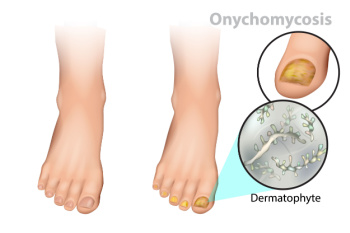Connect With Us
Blog
Items filtered by date: July 2025
Common Soccer Foot Injuries and Chiropody Care

Soccer players frequently deal with foot injuries that can interfere with their performance and comfort on the field. Blisters from friction, bruised or damaged toenails, and overuse injuries like plantar fasciitis and Achilles tendonitis are common. Younger athletes may also develop Sever's disease, which affects the growth plate in the heel. These conditions can cause pain, swelling, and limited mobility, if not properly addressed. A chiropodist can evaluate, diagnose, and treat these injuries through custom orthotics, targeted therapies, footwear recommendations, and preventative care. Whether you have a minor irritation or a chronic foot issue, it is suggested that you schedule an appointment with a chiropodist for treatment.
Injuries to the foot and ankle are very common among athletes. If you have experienced an injury, please consult with one of our chiropodists from West Toronto Foot & Ankle Clinic Inc. . Our chiropodist will assess your condition and provide you with quality foot and ankle treatment.
Common Injuries Among Athletes:
- Achilles tendon injuries
- Ankle strains or sprains
- Plantar fasciitis
- Fractures
- Turf toe
- Joint dislocations
- Sever’s disease
- Morton’s neuroma
Symptoms
Symptoms will depend on the cause and severity of the injury. Common symptoms for a foot or ankle injury include pain, swelling, tenderness, bruising, a reduced range of motion, and difficulty bearing weight or walking on the affected foot or ankle.
Diagnosis
Sports injuries are typically diagnosed after carefully examining the affected foot or ankle. This includes moving the injured area to test its range of motion. Medical history will need to be provided, as well as detailed information about how the injury occurred. Imaging studies, such as X-rays or MRIs, may be used to confirm or rule out certain diagnoses.
Treatment
Just like symptoms, treatment will depend on the type of injury and its severity. Initial treatment for many sports injuries is aimed at controlling inflammation and promoting the healing response. The acronym R.I.C.E is a helpful guide to implement for most acute injuries. This method involves resting, icing, compressing, and elevating the affected foot or ankle. In addition, anti-inflammatory medications may be administered and orthotic devices may be prescribed. For more severe injuries, surgery may be required. Lastly, rehabilitation or physical therapy may be needed to gain full functionality in the afflicted area.
If you have any questions, please feel free to contact our office located in . We offer the newest diagnostic and treatment technologies for all your foot care needs.
Finding Relief from Plantar Fasciitis

Plantar fasciitis is one of the most common causes of heel pain, often felt most sharply with the first steps in the morning or after long periods of rest. It occurs when the thick band of tissue along the bottom of the foot becomes irritated or overstretched, leading to inflammation where it attaches to the heel bone. While the pain may ease with movement, it often returns without proper treatment. Managing plantar fasciitis involves reducing strain on the foot while supporting healing. Rest and targeted stretching can help relieve symptoms early on. Wearing supportive footwear with good arch support and cushioning is key. Many people also benefit from custom orthotics to offload pressure from the heel and improve alignment. If pain continues, treatments may include splints worn at night, or advanced options such as shockwave therapy. For ongoing or worsening symptoms, it is suggested you see a chiropodist for diagnosis and treatment tailored to your needs.
Plantar fasciitis can be painful and interfere with your daily activities. If you are experiencing foot or heel pain and believe you may be afflicted with plantar fasciitis, please consult with one of our chiropodists from West Toronto Foot & Ankle Clinic Inc. . Our chiropodist will assess your condition and provide you with quality foot and ankle treatment.
What Is Plantar Fasciitis?
Plantar fasciitis refers to the inflammation of the plantar fascia, a ligament that runs along the bottom of the foot and connects the heel bone to the toes. Repetitive activities, such as running or jumping, can injure the plantar fascia over time. Plantar fasciitis can also be caused by flat feet, high arches, pregnancy, and activities that put excessive pressure on your feet, like standing all day for work. When the plantar fascia becomes inflamed, it causes pain and discomfort.
Symptoms
Typical symptoms of plantar fasciitis include:
- Stabbing pain near the heel
- Pain that is worst in the morning or after a period of rest
- Pain that increases after exercising
- Swelling
- Tightness in the Achilles tendon
Diagnosis
Plantar fasciitis is typically diagnosed via medical history and physical examination.
Treatment
Treatments for plantar fasciitis include resting and icing the affected foot, stretching the foot, taking medications to reduce inflammation, and wearing orthotics. In severe cases where pain does not improve with conservative treatments, injections or surgery may be recommended.
If you have any questions, please feel free to contact our office located in . We offer the newest diagnostic and treatment technologies for all your foot care needs.
Types and Symptoms of Toenail Fungus

Toenail fungus, also called onychomycosis, is a common condition caused by various types of fungi, including dermatophytes, molds, and yeasts. Dermatophytes are the most frequent culprits, often affecting the toenails more than the fingernails. Infected toenails may turn yellow, green, or brown and appear thickened, brittle, or crumbly. In some cases, the nail may separate from the skin underneath, emit an unpleasant odor, or cause pain when walking or wearing shoes. Different subtypes of infection exist depending on the area of the nail affected, such as the tip, base, or surface. Risk factors include walking barefoot in public areas, wearing tight shoes, nail trauma, and medical conditions that lower immunity. A chiropodist can examine the affected toenail, determine if it is fungal, and suggest appropriate topical treatment. If you have developed a fungal toenail infection, it is suggested that you schedule an appointment with a chiropodist for appropriate treatment.
Toenail fungus can be uncomfortable and unsightly. If you have diabetes or a compromised immune system, it may also be dangerous. To learn more about treatment options, please consult with one of our chiropodists from West Toronto Foot & Ankle Clinic Inc. . Our chiropodist will assess your condition and provide you with quality foot and ankle treatment.
What Does Toenail Fungus Look Like?
A fungal infection of the toenail may cause the affected nail to become thickened, brittle, crumbly, and yellowish or brown in color. Sometimes the toenail may separate from the nail bed, become deformed, emit a foul odor, or cause pain or discomfort.
What Causes Toenail Fungus?
Toenail fungus is caused by a fungus that infects the nail bed. The fungus lives and thrives in warm and moist environments and is also contagious. Athlete’s foot, which is a fungal infection of the skin, may spread to the nails and cause toenail fungus.
What Treatments Are Available?
Potential treatments for toenail fungus may include oral antifungal medications, topical antifungal medications, such as medicated nail polishes that are applied directly to the affected nail, and laser therapy. Sometimes, a combination of treatments is prescribed.
If you have any questions, please feel free to contact our office located in . We offer the newest diagnostic and treatment technologies for all your foot care needs.
Causes and Grades of Ankle Sprains

An ankle sprain occurs when the ligaments that support the ankle are stretched or torn, usually due to a sudden twist or fall. Causes include sports injuries, uneven surfaces, or improper footwear. Ankle sprains are graded by severity, with Grade 1 being mild stretching, Grade 2 involving partial tears, and Grade 3 representing complete tears and instability. Risk factors include weak ankles, poor balance, and previous sprains. A chiropodist can assess the injury, recommend appropriate care such as bracing or exercises, and help prevent future sprains through strengthening and balance training. If you experience ankle pain, swelling, or difficulty walking, it is suggested that you schedule an appointment with a chiropodist who can guide you toward appropriate relief and treatment solutions.
When one or more ligaments in the ankle overstretch or tear due to injury, an ankle sprain occurs. If you would like to learn more about ankle sprains, please consult with one of our chiropodists from West Toronto Foot & Ankle Clinic Inc. . Our chiropodist can help you maintain the health of your lower limbs and your mobility.
Symptoms of an ankle sprain vary depending on the severity of the injury, but may include:
- Pain
- Swelling
- Bruising
- Tenderness
- Difficulty walking
- Ankle instability
- A reduced range of motion in the ankle
Treatments for an ankle sprain may consist of:
- Resting the injured ankle
- Applying ice
- Elevating the ankle
- Compressing the ankle
- Over-the-counter pain medications
- Ankle braces or other devices to take weight off of the ankle
- Ankle exercises
- Surgery (in rare cases)
It’s important for the sprained ankle to heal correctly and fully in order to avoid repeated injury. If you have any questions, please feel free to contact our office located in . We offer the newest diagnostic and treatment technologies for all your foot care needs.
Plantar Warts Can Be Treated!
Essential Foot Care for Diabetic Feet

Proper foot care is vital for individuals with diabetes to prevent serious complications. Keeping the skin soft with a gentle moisturizer helps avoid cracks that can lead to infections. Daily foot inspections are important for spotting blisters, cuts, or redness early. Washing feet with mild soap and drying them thoroughly, especially between the toes, helps maintain cleanliness and reduces moisture buildup. A chiropodist plays a key role by providing routine foot exams, managing calluses or nail care, and offering guidance on footwear and skin health. If you have diabetes, it is strongly suggested that you are under the care of a chiropodist who can help you to manage this serious condition.
Diabetes can cause serious problems in the lower limbs if proper preventive measures are not taken and diabetic wound care is not performed. If you would like to learn more about caring for diabetic feet, please consult with one of our chiropodists from West Toronto Foot & Ankle Clinic Inc. . Our chiropodist can help you maintain the health of your lower limbs and your mobility.
Diabetes can lead to a host of foot and ankle complications, including:
- Poor circulation
- Peripheral neuropathy
- Diabetic foot wounds and ulcers
- Infection
- Corns and calluses
- Dry, cracked skin
- Nail disorders
- Hammertoes
- Bunions
- Charcot foot
If you have diabetes, you must be vigilant of any changes in your foot health. This is best done through daily foot inspections. Using a mirror to help you if necessary, look for any:
- Cuts, scrapes, sores, or wounds
- Bruising or discoloration
- Swelling
- Rash
- Foul odor
- Nail changes
- Hair loss
- Warmth and inflammation
- Deformities
- Lower limb pain
- Strange sensations (numbness, tingling, burning, pins, and needles)
If you detect anything unusual, seek the care of a chiropodist as soon as possible. If you have any questions, please feel free to contact our office located in . We offer the newest diagnostic and treatment technologies for all your foot care needs.
Blog Archives
- November 2025
- October 2025
- September 2025
- August 2025
- July 2025
- June 2025
- May 2025
- April 2025
- March 2025
- February 2025
- January 2025
- December 2024
- November 2024
- October 2024
- September 2024
- August 2024
- July 2024
- June 2024
- May 2024
- April 2024
- March 2024
- February 2024
- January 2024
- December 2023
- November 2023
- October 2023
- September 2023
- August 2023
- July 2023
- June 2023
- May 2023
- April 2023
- March 2023
- February 2023
- January 2023
- December 2022
- November 2022
- October 2022
- September 2022
- August 2022
- July 2022
- June 2022
- May 2022
- April 2022
- March 2022
- February 2022
- January 2022
- December 2021
- November 2021
- October 2021
- September 2021
- August 2021
- July 2021
- June 2021
- May 2021
- April 2021
- February 2021
- January 2021

